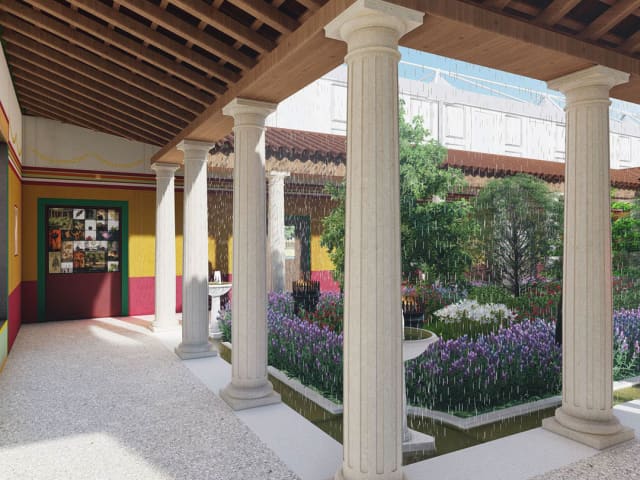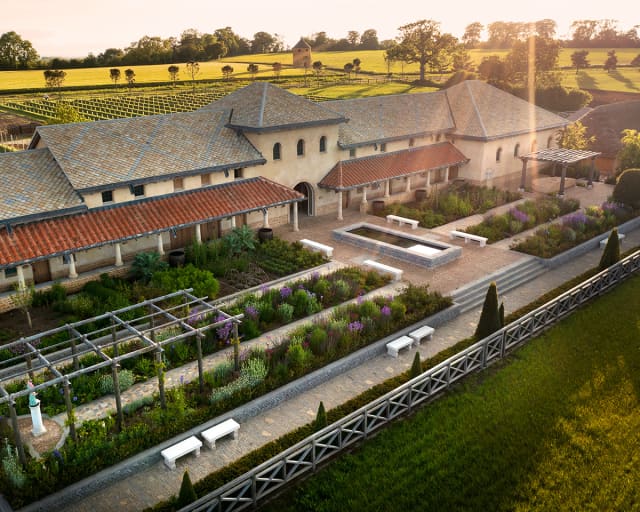From planting for wellbeing to effective use of light, colour and space, there’s much to inspire at this year’s RHS Chelsea Flower Show Roman Garden. We dig into the history with Exhibitions Manager, Ric Weeks

As Monty Python fans will know, the Romans have done nothing for us except for giving us sanitation, medicine, roads, irrigation, education, wine, public health, and the fresh water system. With this year’s RHS Chelsea Flower Show garden, we’re also adding gardening to the list.
Our 1st Century peristyle garden within the walls of a replica Roman Villa is a reimagining of a garden you might have found in ancient Pompeii. “We’ve chosen 78CE because it’s the year before Pompeii was buried in pumice from the eruption of Mount Vesuvius”, explains Ric Weeks, onsite archaeologist and exhibitions manager at The Newt. “The archaeology in Pompeii survives like a time capsule, so it is the best inspiration in the Roman world.”
Based on perfectly preserved examples of the day, in particular the House of the Golden Cupids in Pompeii, we can be confident with what we’re trying to recreate at Chelsea.
Mixing Practicality with Pleasure
“The Romans were the earliest pioneers of creating beauty through the interplay of nature and architecture,” says Ric. “They made use of aesthetic choices such as colour, fragrance and ornamental planting to bring outdoor spaces to life and make them joyful and fun. They were great growers from a practicality point of view and also incorporated medicinal plants that they could make use of. This resonates with modern gardeners and it’s something we at The Newt are keen to share.”

A Roman Garden is planted with a tapestry of topiary, trees, herbs, medicinal species and popular ornamentals of the time. Visitors to RHS Chelsea this year can also enjoy frescoes, fountains within a water rill and a shrine framed by colonnaded surroundings for a true experience of ancient Pompeii.
“I personally find the incorporation of the water feature really interesting,” explains Ric. “It’s got a surprise because assuming the weather's good, it will come on at periodic points during the day adding an atmospheric element to the garden. Water was so important to the Romans. As pagans, they very much believed in the elemental nature of water and how it could link them directly to the other world. They would use shrines at water points, to make offerings to the gods.”
A peristyle garden would have been at the heart of a Roman home, linking outside with inside. “They are open to the elements from above, but incorporate a covered surround which gives shelter,” says Ric. “The Romans had a very different approach to the outside in that they didn't really view it as a separate part of the home. Natural light back in the Roman world was imperative. The only artificial light they had was oil lamps and candles, which were expensive, and actually making the most of natural light was very good for you.”
Bringing History to Life
Honouring the traditions of gardening from ancient to modern times in a playful and innovative way has always been at the heart of The Newt in Somerset’s experience. A Roman Garden is an extension of this. “It’s telling the story of our ancestors and how that relates to what we have here on the estate,” explains Ric.
“We’ve got our own links to Pompeii at Villa Ventorum,” he says. “When we’ve come to recreate frescoes in our reconstructed Bath House, we've chosen colour palettes that have survived in the fresco plaster that we've excavated, but we haven't got whole patterns. In that circumstance, we've taken inspiration from Pompeii and its many famous frescoes and given them a slight Romano-British Somerset twist.

“We have an education programme on the estate, which we run every Tuesday and Thursday during school term time,” adds Ric. “To date, over 3,000 children have come to enjoy the Roman Villa Experience. It’s something that we offer entirely free to schools and it’s a wonderful thing to be able to inspire young minds.” It’s a programme we’re growing further with new initiatives such as our Forest School Holiday Club, in addition to an extensive array of workshops, unique guest experiences and apprenticeships.
Whether you’re visiting us at the RHS Chelsea Flower Show next week or stepping back in time at our expansive Romano-British Villa, we’re looking forward to sharing our knowledge and learnings and celebrating it.
• Visitors to RHS Chelsea Flower Show can find ‘A Roman Garden’ at the end of Main Avenue, next to the RHS Garden.
Discover More
• The Roman Villa Experience at The Newt is open every day. Timed slots are available from 9.30am - 5pm, with last entry at 3.30pm.
Plan Your Visit



